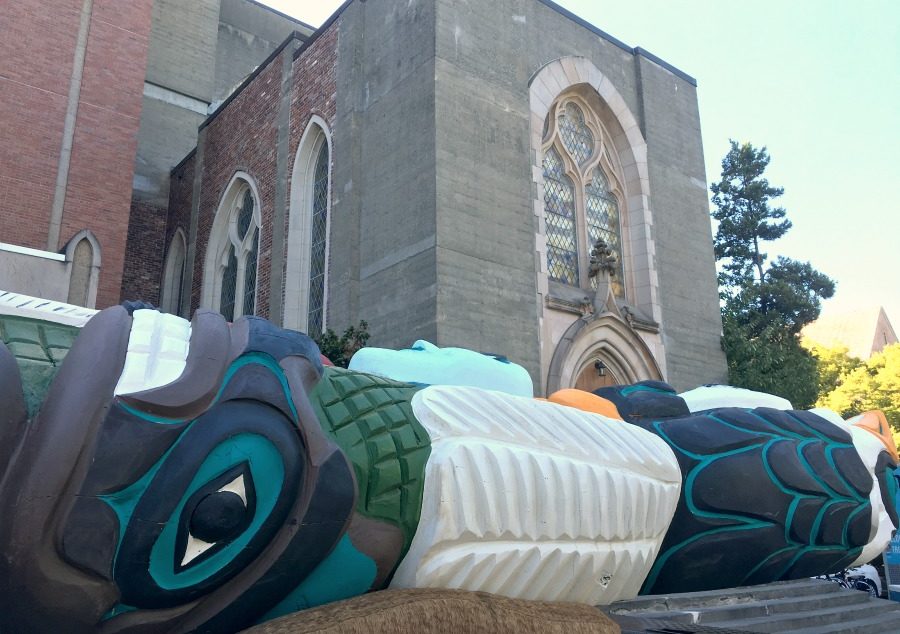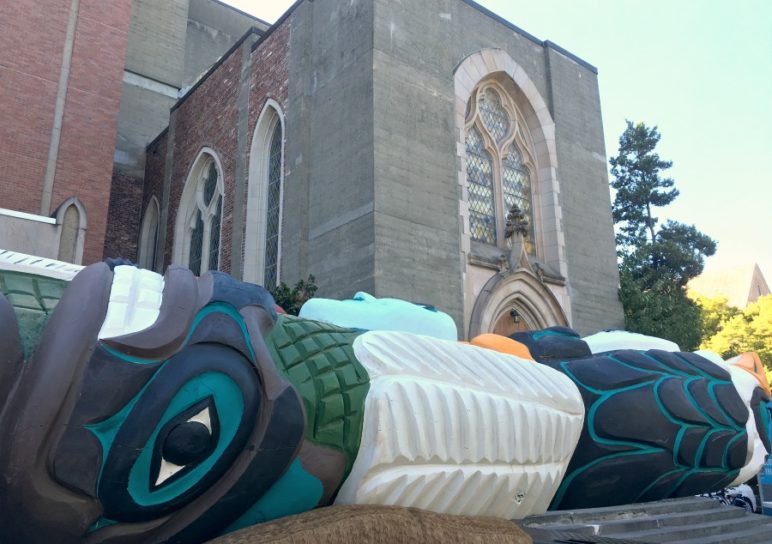Editor’s Note August 2016: Last week during the Lummi Totem Pole Journey stop in Seattle, Sightline senior researcher Tarika Powell had the privilege of speaking alongside leaders from the Lummi Nation, Quinault Nation, White Swan Dakotas, and more, about the fight against coal, oil, and gas infrastructure in the Northwest. The ceremony brought together 300 people and strengthened connections between tribes, people of faith, civic leaders, and activists. Due to the requests from attendees, we are publishing Tarika’s speech below. You can follow the totem pole journey here.
If these energy firms are successful, they will unleash the carbon equivalent of roughly five Keystone XL Pipelines upon this region.
The Pacific Northwest has long been recognized as a global leader in sustainability. But in the past ten years, our region has faced the prospect of becoming one of the nation’s main gateways to export fossil fuel into overseas markets.
To the casual observer, this may seem surprising. We’re not the Gulf Coast. We don’t have many fossil fuel resources in Washington and Oregon. So why would the fossil fuel industry want to turn our region into a fossil fuel hub?
It is by geographic accident that the Northwest, perhaps the greenest corner of North America, will play a pivotal role in determining the planet’s climate future. Big energy companies want to unearth vast reserves of carbon and methane-intensive fuels and put them up for sale in Asia, where the profits would be higher than here in the United States. Fossil fuels are being fracked and mined in North Dakota, Wyoming, Montana, and Alberta. The cheapest and most direct way to get these fossil fuels to overseas markets is through our ports in Washington, Oregon and British Columbia.
So solely because of geography, our communities, our air, our water, our fish, our coastal tourism, and our traditional ways of life are in the crosshairs of the fossil fuel industry, which wants to get coal, oil and gas from the interior of North America to markets on the other side of the Pacific Ocean as cheaply as possible. We face this danger for no other reason than that we’re a shorter transportation route. To the fossil fuel industry, we’re little more than a waystation in the global fossil fuel supply chain. The other considerations of our lives and health are something that the backers of export projects are not looking at.
If these energy firms are successful, they will unleash the carbon equivalent of roughly five Keystone XL Pipelines upon this region. To get their products to the market, energy companies must first build new terminals and pipelines to move all that fuel. They need destinations for the thousands of oil and coal trains that they plan to run across the Northwest, and they need right-of-ways to lay new pipelines through our private land, public forests, and waterways.
Most Americans want to move past dirty energy sources. We don’t want our present or our future to be tied to these fuels. But because of the Northwest’s proximity to markets that do have high demand for dirty fuels, we have seen several waves of proposed fossil fuel projects in our region that would expand fossil fuel markets and worsen climate change. This would enrich some of the most profitable corporations on earth, and tie our region to fossil fuel terminals, exploding trains, and leaking pipelines for decades.
While we have asked to move beyond fossil fuels to more sustainable energy sources, the fossil fuel industry has proposed massive projects in three waves.
First was the wave of coal projects. Coal terminals are fed by coal trains, which travel through our region uncovered, emitting coal dust into the air and onto land and water. A 2006 study in BC near the Westshore Coal terminals found widespread coal dust not just on the surface of the water, but it was accumulating on the sea floor up to two miles away from the terminal. The oxidizing coal dust could reduce the oxygen available for flora and fauna that live on the sea bottom, which make up a large share of the seasonal food for salmon and herring. Coal dust also increases health concerns for people who live near rail lines. Luckily, the Northwest has had success in defeating new coal export terminals.
The Lummi Nation stood in the way of the Gateway Pacific terminal, which would’ve been North America’s largest coal terminal, built on a sacred site, scattering coal dust through the treaty fishing waters of a number of tribes. The Lummi won a decision by the Corps of Engineers in May 2016 to halt the project. That victory that was celebrated far and wide; it was not just a victory for the Lummi Nation, but for every nation that intersects here in this region.
The second wave was a wave of oil proposals and terminal expansions. These proposals would turn our region into a thoroughfare for explosive oil trains. Even though one of the most devastating oil spills in Washington’s history happened at Grays Harbor, near Quinault lands, we got three proposals to expand oil transportation through Grays Harbor. Research on the potential impacts to coastal tourism and treaty fishing shows that Grays Harbor is still unprepared for an oil spill. An oil spill would devastate the economy of the Quinault as well as migratory bird populations. Our state’s income from coastal tourism would also take a major hit – 40% of Washingtonians travel to the coast each year. So we’ve fought the terminals proposed for Grays Harbor, and now two of them are dead.
The third wave in the attempt to turn our region into the new Gulf Coast has been proposals to export massive stores of liquid natural gas. We had several proposals near the Columbia River that would have been equal in size or larger than the largest liquid natural gas terminals in the world. We have defeated all of them.
Today, at the Seattle stop of the Totem Pole Journey, we celebrate these victories again. We have saved hundreds of miles of private land, public forests, and waterways from the harmful impacts of pipeline infrastructure. We have taken decisive steps to stop pipelines, oil trains, and coal trains in their tracks.
In fact, we are so good at defeating the fossil fuel industry that industry insiders have said, “The Pacific Northwest is where fossil fuel projects go to die.”
Today the fossil fuel industry is not at the height of its power, but we are at the height of our power.
But when you are fighting on the ground, pushing back a wave of projects only to be hit by another wave—defeating a coal proposal only to be hit by a natural gas proposal, as the Lummi were —you don’t always feel so powerful. You start to feel that as soon as you have one victory, another problem arises.
But I’m going to tell you not to get discouraged just because there’s more work to do.
Ever since our society began to base our transportation, homes, and prosperity around fossil fuels, the work has always been large. The multiplicity of the problem has always been there. But that looming threat we faced five years ago—when the fossil fuel industry looked so powerful that its designs for our region seemed inevitable—is ebbing. The industry is no longer swelled with confidence. That threat is being defeated.
Our victories have been larger than their plans. Today the fossil fuel industry is not at the height of its power; instead, we are at the height of ours.
We stand here in Washington, Oregon, and British Columbia at the crossroads. In order for big energy companies to get these fracked fuels and coal to markets across the Pacific, they have to go through us. They need our permission to cross. We don’t have to worry that it will never end when we know exactly where we are in the fight.
So here’s where we are: Our victories are preventing decades of greenhouse gas pollution. Our choices are improving not only our region’s health and safety – they are shaping our entire planet’s future.
It has taken us a while to get to into the place of having the power to control the crossroads. But now here we are, in the Pacific Northwest, where several cities have passed resolutions to limit fossil fuel infrastructure and Portland is in the process of doing the same… Where city and county governments are taking strong steps to limit oil trains… Where communities like Tacoma, which has long struggled with industrial pollution, just defeated a proposal that would’ve been the largest methanol terminal in the world.
We are a Thin Green Line that stands between the fossil fuel companies and the markets they want to reach. We can, we have, and we will continue to deal the industry a devastating blow that will keep it off of sacred lands, away from the air we breathe, the food we eat, and the waters we all rely on.
Our victories are preventing decades and decades of greenhouse gas pollution.
We have to hold that Thin Green Line strong by realizing that when we were hit with each wave, we survived, and they got closer to insolvency. And now we are changing our laws so that the waves will stop coming.
A few days ago, the House of Tears Carvers began a 5,000-mile trip across the western United States and Canada with a beautiful totem pole to bring attention to what the industry is trying to do to our region. You might not be accompanying this totem pole throughout its entire journey. But you can still journey with us by helping to protect treaty rights, helping protect our economy and future, and keeping this issue in the forefront of your actions.
Let the fossil fuel industry know that our journey has brought us to this time when we meet their unprecedented push with an unprecedented power to stand in the way. Let’s keep eroding this industry, and let’s keep doing that together.












Nicholas Fay
Hello! My name is Nick Fay, and I am looking to do a documentary following a personal story in regards to climate change in Washington. I am looking for a story, something I can show as well as tell. Maybe someone fighting to better the climate, or the effect that the climate has on that person. Do you have any references? Thank you so much! I want to spread awareness so thanks!